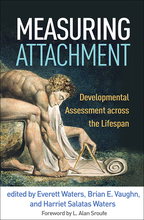Measuring Attachment
Developmental Assessment across the Lifespan
Edited by Everett Waters, Brian E. Vaughn, and Harriet Salatas Waters
Foreword by L. Alan Sroufe
Hardcovere-bookprint + e-book
Hardcover
orderMay 10, 2021
ISBN 9781462546473
Price: $72.00 478 Pages
Size: 6⅛" x 9¼"
“As interest in the study of attachment beyond the early years of life has burgeoned, a number of new measures for assessing attachment have been developed. In this volume, renowned attachment researchers have organized an excellent array of contributors who have conducted careful work on validating these new measures. The editors have provided a valuable tool for developmentalists, graduate students, pediatricians, clinical psychologists, social workers, and psychiatric researchers. I look forward to using this book in my graduate classes in developmental science, clinical psychology, and developmental psychopathology.”

—Dante Cicchetti, PhD, Institute of Child Development (Emeritus), University of Minnesota
“Rich in history and theory, this is a compelling work for researchers, clinicians, and students interested in the assessment, measurement, and definition of constructs critical to the attachment system. All in one place, readers can find thorough consideration of the best-validated, state-of-the-art methodologies used to assess attachment throughout the lifespan (including the neglected periods of middle childhood and adolescence). This important guide provides links to measurement manuals; offers insightful tips for observation, scoring, interpretation, and the training of coders and research assistants; and explains key constructs. This is an impressive reference for scholars and practitioners at any level interested in the developmental continuity and intergenerational transmission of attachment.”

—Jennifer C. Ablow, PhD, Department of Psychology, University of Oregon
“In my teaching and advising, I am always asking students: 'How was attachment measured?' Student responses indicate how little attention is given to attachment measurement, making this a timely and needed resource. I can see assigning this book in my doctoral seminar on attachment theory and research. The chapters are written by the leading figures in the field and provide essential information for new and more seasoned researchers, students, and clinicians. This invaluable contribution is a one-stop shop to compare and evaluate attachment measures across the lifespan.”

—Richard Lanthier, PhD, Graduate School of Education and Human Development, The George Washington University
—Dante Cicchetti, PhD, Institute of Child Development (Emeritus), University of Minnesota
“Rich in history and theory, this is a compelling work for researchers, clinicians, and students interested in the assessment, measurement, and definition of constructs critical to the attachment system. All in one place, readers can find thorough consideration of the best-validated, state-of-the-art methodologies used to assess attachment throughout the lifespan (including the neglected periods of middle childhood and adolescence). This important guide provides links to measurement manuals; offers insightful tips for observation, scoring, interpretation, and the training of coders and research assistants; and explains key constructs. This is an impressive reference for scholars and practitioners at any level interested in the developmental continuity and intergenerational transmission of attachment.”
—Jennifer C. Ablow, PhD, Department of Psychology, University of Oregon
“In my teaching and advising, I am always asking students: 'How was attachment measured?' Student responses indicate how little attention is given to attachment measurement, making this a timely and needed resource. I can see assigning this book in my doctoral seminar on attachment theory and research. The chapters are written by the leading figures in the field and provide essential information for new and more seasoned researchers, students, and clinicians. This invaluable contribution is a one-stop shop to compare and evaluate attachment measures across the lifespan.”
—Richard Lanthier, PhD, Graduate School of Education and Human Development, The George Washington University



